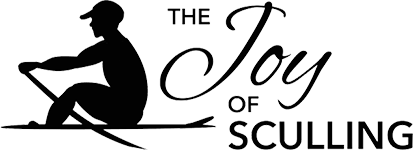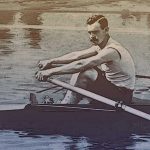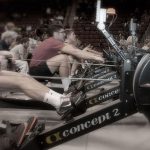The Beginning Sculler
Where do you begin the instruction? Before you start on the water have the athlete hold the scull at the dock side emphasizing a finger hold of the handle. Have them place the scull in the water at blade depth and hold the handle with the fingers with the thumb over the end of the handle. The first finger will be exactly placed at the end of the handle and the knuckle line will be at the forward edge of the handle.
Now the athlete is ready to enter the shell. Holding the boat have them do a one foot step in and down. You should probably demonstrate this first.
Then it makes good sense to have the young athlete sit at the release position where it is most stable. It will be more stable if they keep the hands level and working close together with little space between them. The trunk is slightly past the body at 15 degrees with the legs down firmly; you are pushing with legs and trunk against the old bow door waiting for the hands to come in and out of the body in a continuous, steady movement. They can see the levelness when the hands are in front of them and they can also feel it (anatomical pinpoints) when they nudge the stomach wall at the point of the release with each handle. It is pointed out to the athlete that there is little difference in the rigger heights, one quarter of an inch between the rigger heights or level in infinity by old Euclidian geometry. The level hands becomes an immediate point of concentration in their sculling. It is level with little vertical space between the hands. They should as tall as possible.
Now the athlete’s concentration focuses on the finger hold of the handles, so review the position of the fingers on the handles. When the blade is squared in the water the knuckle line should be at forward edge of the handle allowing the fingers to drop and the wrists to be flat. The handles are positioned at the same height as previously stated. When hands are drawn to the abdominal wall the hands are again at the same height.
Elbows remain positioned in the line of pull, relaxed and slightly angled to the body wall. The athlete can do some continuous sculling from this position concentrating on keeping the blade at blade depth and the hands working in close approximation. This will keep the shell level.
On the moving forward there should be a little reach from the hips as well as from the arms. Keep the position athletic looking and not awkward or overstretched. Their full reach at this point in the development is done as they slide forward. Sitting at the back of his slide, the release can now be practiced. With a slight downward pressure on the handles release the blade a quarter of the blade width out of the water.
At this point allow the blade to be feathered using your fingers and send the handles forward. Use as little of the wrists as possible for executing this relaxed feather action. It is a little rounded action, an over the barrel movement. There is little dropping of the hands and absolutely none by the trunk or forearms. The dropping of the body parts stops the continuous surge of the shell running out between strokes where races are won.
The Trunk Swing
It is a work of art. Divine is the feel. Ease and relaxation
are paramount. Full range of movement, with hips
projecting the movement from release to entry.
Sit lightly on the seat and let
“the wind blow under your bottom.”
Shell slides easy beneath you.
– Jimmy Joy
The trunk swing is either taught as the conventional approach with the abbreviated swing or the full swing movement. The abbreviated swing movement consists of setting the trunk angle out of the bow. In contrast, with the full trunk swing, the quantum approach, the body angle changes from the release to the entry with a steady muscle movement from the hips. You can feel the hip muscles and the seat working together over the full slide. Fifty years ago, Fitzpatrick said that once you have experienced the swing, your body will never forget it and he was right.
To this day, with the first stroke, I can feel the integration at the entry, the solid connected drive, and the beauty of the release, followed by the simple glide and constant change in the trunk angle moving forward. The shell responds immediately, and I am carried back to those beautiful moments on the Henley course in St. Catharines when I first experienced the integration and flow of the stroke. I will never forget the feeling of exhilaration, power, and rhythm. I was experiencing the flow state. My whole body was in a state of flow with the shell. Everything felt so easy. This is really where the individual development of mind and consciousness occurs. George Pocock wrote, “I’ve heard men shriek with delight when that swing came in an eight; it’s a thing that they’ll never forget as long as they live.”
The trunk swing is the foundation of the stroke cycle, the keystone in the arch of skill. A sculler should really feel the movement of the hips forward and backward. It is the muscles of the hips that control the movement of the seat on the recovery. Steve Fairbairn wrote, “All races are won by the crew with the best forward swing.” The swing displays a full range in the angle of the trunk over the length of the slide. Everything is moving and changing. There is no setting of the trunk angle out of bow.
The trunk swing at the end of the drive and beginning of the recovery is somewhat complicated in that you swing 15 degrees through the perpendicular and then pause waiting for the hands and arms to come in and out to the straight arms. This brings the trunk slightly through the perpendicular and this is where the seat begins to move forward to the entry. Do one quarter slides drill after a couple of days with them. Now you have the five movements of the release and follow through looking like one movement.
You have the athletes sit their full length from the hips so the shoulders are relaxed. Then you are ready to practice the trunk swing from the hips as a solid relaxed column over the full length of the slide. The angle of the trunk is constantly changed over the full length of the recovery. The full reach from the hips reaches its maximum length at the moment of entry. It is the precise timing of the seat, the blade and the trunk to the entry that you are trying to feel in your sculling. When you achieve this timing there is absolutely no pause in the movement of the blade at the entry. It simply disappears from the feather position. It is a two cycle entry, drop the blade in and pull. The three cycle entry is square the blade above the water, enter and three, pull.
To drill on the timing of this recovery you do setins from the back of slide. Gradually you move up the slide from a quarter setin to half slide stint three quarter slide setin to eventually a full slide satin. So are redefining what is full slide as the athlete becomes more comfortable with his levelness.
On the recovery you skim the blades on the water for the novice. For the experienced sculler the blades occasionally touch the water; Pocock talks about this carrying method of the sculls on the recovery for the experienced person. The important point coming into the entry is that the legs are splayed and are rock solid. This legwork is your foundation for your drive. The splay of the legs comes from the “trim” of the shell, the foot stretchers are splayed and to keep your lower and upper legs aligned you have to slay the legs. Look at your legs when you are sitting on land with the feet parallel and than splay the feet imitating the condition in the shell. Doing this you see your knees move out to the splayed position. Keep your shoulders in the armpits and no wider. And keep your shoulders level and relaxed. The hands move up from the toes to full reach and this prevents any pitching of the shoulders at the end of this recovery. The stomach distends downwards at this point in the stroke. All of this instruction becomes one half of the complete stroke. The other part or half is the drive to the release. The two wholes.
Here’s a short clip of Jim Joy teaching from the single in 2007.

















